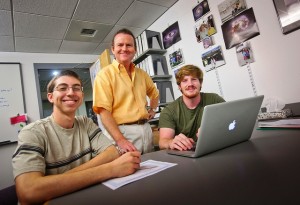David Nice, associate professor of physics, and a team of students are bringing the role of gravitational waves—ripples in space-time generated by very distant massive black hole binary systems—into perspective through their research on pulsar timing.

Anthony Post ’14, l-r, Professor David Nice, and Joseph Tumulty ’14 in Hugel Science Center
Nice is part of an international group of physicists that received a $6.5 million, multi-institution grant from the National Science Foundation; Lafayette’s portion is $145,000. The group is using the Arecibo Observatory in Puerto Rico, along with other radio telescopes, to make observations on pulsars, which are rapidly rotating stars that emit beams of radio waves.
“As the star rotates, once per rotation, the beam sweeps across the Earth. We detect this as a ‘pulse’ of radio waves, hence the name pulsar,” says Nice. “This is like looking at a lighthouse and seeing it regularly blink on and off, even though what is really happening is the light source is rotating—the rotating mirror or lens in the lighthouse causes the beam to move around.”
A typical pulsar is a few thousand light years away from Earth, meaning that the pulses it emits travel for thousands of years before they reach the Earth and can be detected with a radio telescope.
“For some pulsars, we can predict when the pulses will arrive to within a millionth of a second, even though they have traveled for thousands of years to reach us. If you think about those numbers, that’s pretty amazing.”
Nice and his collaborators collect data from the Arecibo telescope by observing 18 pulsars once a month. EXCEL Scholars and physics majors Joseph Tumulty ’14 (Ramsey, N.J.) and Anthony Post ’14 (Centerville, Mass.) have had the opportunity to make many of these observations. The trio traveled down to Puerto Rico for a data collection run during the summer. Tumulty and Post have also made observations remotely, controlling the telescope via the internet from physics department computers in Hugel Science Center.
“This research has given me some insight into how physics research is conducted on a professional level. I have learned that physics is more than just a field of study—it’s also a thought process,” says Post. “It has also given me the opportunity to see what data-taking is like outside of a lab course setting and to explore a possible career choice after Lafayette.”
As another part of the project, Tumulty and Post have been researching how the effect of ionized gas on the pulses varies as the Earth and pulsar move through space. They have developed algorithms for analyzing the data, implemented the algorithms in computer code, and then used their code to study the data.
“I like this type of project because it exposes students to experimental physics techniques and to computer programming and data analysis,” says Nice. “Science research is very different from classroom work, and it is absolutely critical that science students experience work in a real research environment. The EXCEL program is invaluable for this. Working with them allows me to delve my research into areas which I otherwise would not study, and has been a channel for all of us (both the students and me) to learn new data analysis skills and techniques.”
Tumulty, who hopes to do graduate work in astrophysics, says, “Through this project I have learned a great deal about the subject of our research, as well as the tools of a researcher, such as programming and operating giant radio telescope receivers. This experience will be a great supplement to my education and career in one way or another.”
